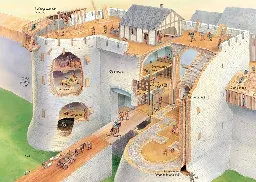No washroom or toilets?
It’s the room directly off the side of the drawing
Having an open courtyard house is one of my biggest house dreams. A nice bit of garden hidden in the home, plenty of fresh air.
I’m right there with you. Every time something like this gets posted I’m like “damn”
Wait, so fancy roman homes had like knick knack shops and shit built in the front of them?
Mixed use zoning.
Reject Modernity: Abandon your home in an isolated residential development/neighborhood.
Return to Tradition: Embrace functional urbanism.
Ohhhhh you’re talking fantasy like TV shows where characters have apartments right above/very close to useful social centers, like bars or restaurants.
Cool to think upper class was like sitcom living for Roman’s.
Lol I love how that’s just how a lot of people live nowadays in Europe. America is wild.
Aaaaand: Having a kitchen was considered upper class, eating out was for the lowers, if I remember correctly.
Correct, though with the addendum that having a kitchen pretty invariably also meant having a chef (or at least a dual-use servant-chef), and that the rich were constantly eating at each other’s houses and critiquing each other’s food.
The Sparticus TV show I liked did NOT imply eating out was for lower classes.
Frfr
/horny
Yep! There was a social aspect to this - client-patron relationships were very prominent in Rome; as such, those shop fronts were often rented out to one’s clients, rather than just the highest bidder. Depending on individual wealth, prominence, personal inclination, etc, this could be as distant and impersonal as one’s political supporters (“Vote for me, filthy poor, and I’ll let you in on prestigious opportunities”), or as close as an aristocrat’s family friend (“Dear Gaius’s grandfather saved my grandfather back in The Day, he’s a good fellow and we try to help him”).
Did the Romans have doors? Or did they use curtains or something similar? What was more common?
I see several curtains in the picture but I’m not sure if there’s a door somewhere.
Yes they had doors. The giant bronze doors of San Giovanni in Laterano are the original doors from the Roman Senate.
Most areas that lead to courtyards are curtains to help with airflow while ones that open out to the public are wood.
https://commons.m.wikimedia.org/wiki/File:Plaster_cast_of_folding_doors,_Pompeii.jpg
It’s also worth mentioning that the climate where these were built was, how they say in the real-estate business as, really fucking nice. They had doors, but walking through an open-air courtyard to get between rooms was hardly an inconvenience for interior comfort. I think doors were really just for privacy and maybe some rudimentary security at the front entrance.
Romanes eunt domus!
People called Romanes they go the house?





